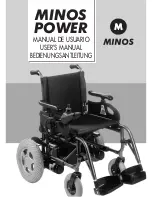
Fi
t a
n
d u
se
10
11
Retractable tie-downs
Retractable tie-downs
1.
The rail will have been installed in the vehicle in accordance with our own and the vehicle
converter’s instruction. Position the wheelchair within the vehicle as required.
2.
Attach the front wheelchair tie-down (not supplied as part of this product) in accordance
with its own instruction.
3.
Place the rear retractable restraint into the rail behind the wheelchair. If using tongue &
buckle attachments, or J-hooks, the retractors are suitable for either left or right hand
use. For restractors with karabiners or hooks, ensure that the open gate of the karabiners
or hooks are facing outboard from the wheelchair, (Fig. 1A). The reversible stalk should be
rotated so that the red buckle button is facing outboard from the wheelchair.
4.
Attach each tie-down into the rail floor by aligning the ATF (aluminium track fitting) feet
with the cut-out sections of the rail, (Fig. 2).
Note: the yellow plungers must face toward
the rear of the vehicle. Press down on the ribbed part of the ATF, (Fig. 2A) and push firmly
down towards the wheelchair until the yellow plunger drops and locks into the rail.
IMPORTANT: Ensure that the plungers are fully engaged on both sides.
5.
Dependent on retractor type, follow instruction:
Quattro: Press the release button(s), (Fig. 1B), to release the webbing and attach each of
the karabiner, hook or tongue and buckle arrangements to the wheelchair’s rear frame.
(Some wheelchairs will indicate this position, Fig. 3). Press the yellow button(s) again to
remove the webbing slack.
Quattro Express:
Webbing can be extended from the reel without pressing the
yellow button if the lock label, (Fig. 1D), is NOT visible. Attach each of the wheelchair
attachments to the wheelchair’s rear frame. (Some wheelchairs will indicate this position,
Fig. 3). The yellow button must be pressed if extending webbing with the label in view,
(Fig. 1C). The webbing will retract automatically into the reel.
IMPORTANT: The yellow
locking label must be fully visible to ensure that the reel is locked off, (Fig. 1D).
6.
Final tensioning is achieved by turning each tensioning handle, (Fig. 1C) until the webbing
is equally taut on each side. Ensure that each rear tie-down webbing is approximately of
the same length and that an angle of around 30° to 45° has been created, within the rear
view zone, (Fig. 4).
7.
An occupant restraint must now be fitted. Please refer to relevant manual.
Removing the combined
retractable tie-downs
IMPORTANT: First remove
the occupant restraint.
1.
Release the tension in
the rears by pressing
the yellow button, (Fig.
1C) and extend the
webbing to allow the
tongue and buckles,
hooks or karabiners
to be removed from
the wheelchair frame.
If the webbing is
particularly tight, it may
be necessary to slightly
’tension’ with the hand
wheel, (Fig. 1B) in order
to remove the webbing
lock on the Quattro.
2.
Lift the yellow plunger
fully, slide back away
from the wheelchair to
align the ATF feet with
the rail cut outs, lift
away from the rail.
3.
Repeat operation with
the opposite tie-down
and store safely.
Fit and use
C
lassic
retractable tie-downs
Rail floor - reversible stalk (I- products) - rear
Figure 4
Rear
securement
points
Wheelchair
reference
plane
45°
30°
SIDE VIEW
REAR VIEW
10°
10°
300mm
(12in)
NOTE Note that angles indicated are obtained by projecting the angle of each tie-down strap
onto a vertical plane parallel to the wheelchair reference plane (side view) or onto a vertical
plane that is perpendicular to the wheelchair reference plane (rear view).
Figure 2
A
D
Figure 1
A
B
C
Figure 3







































